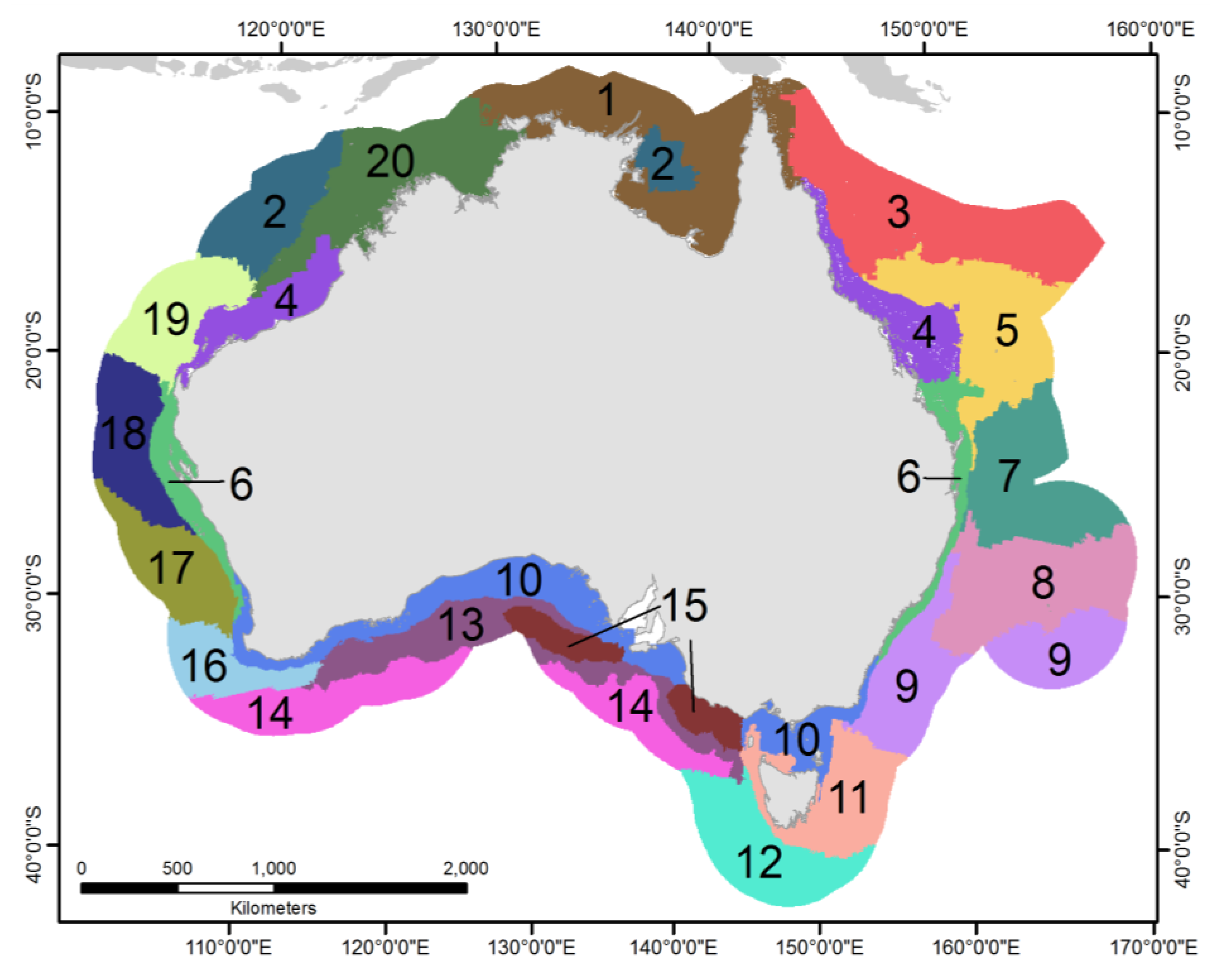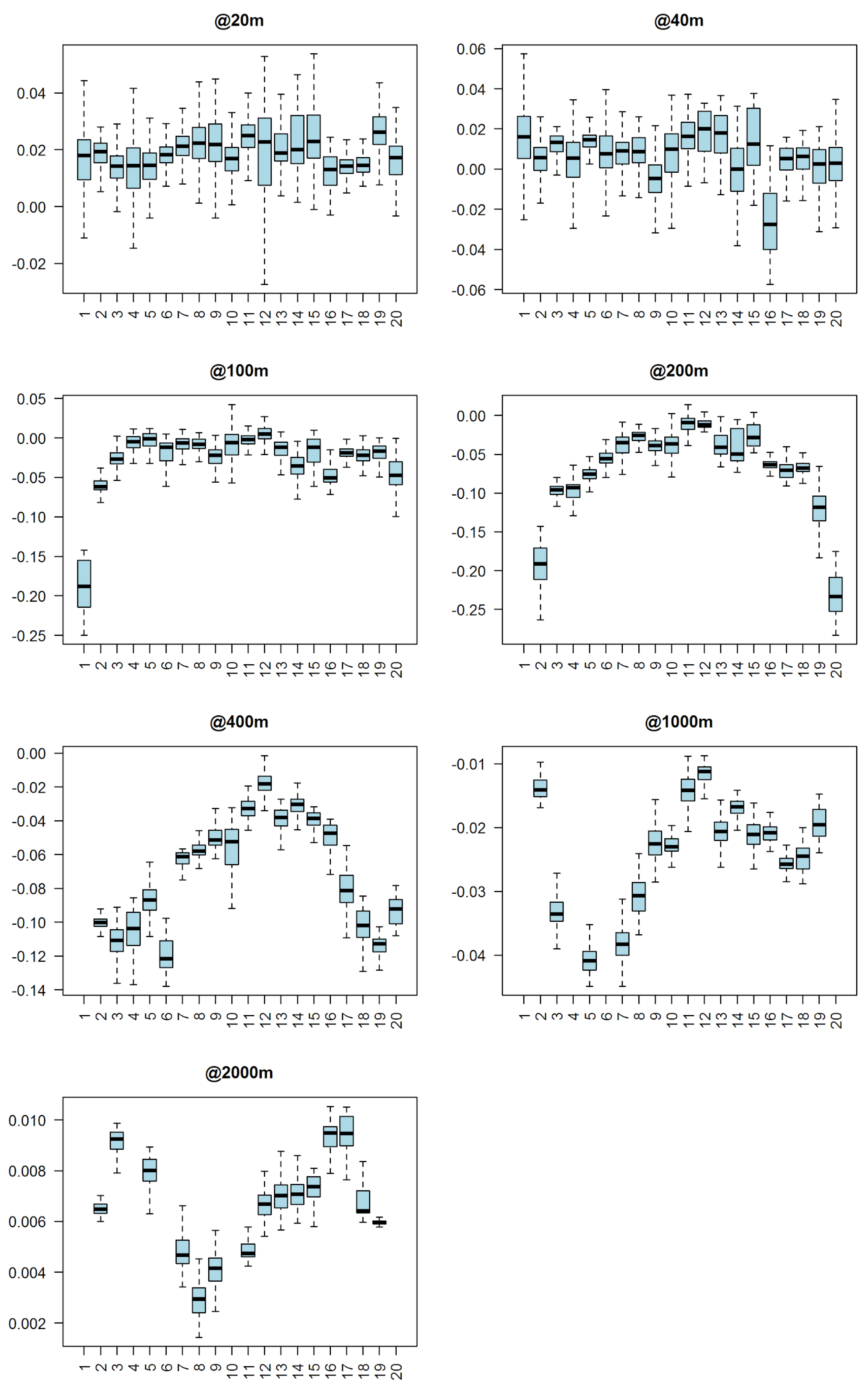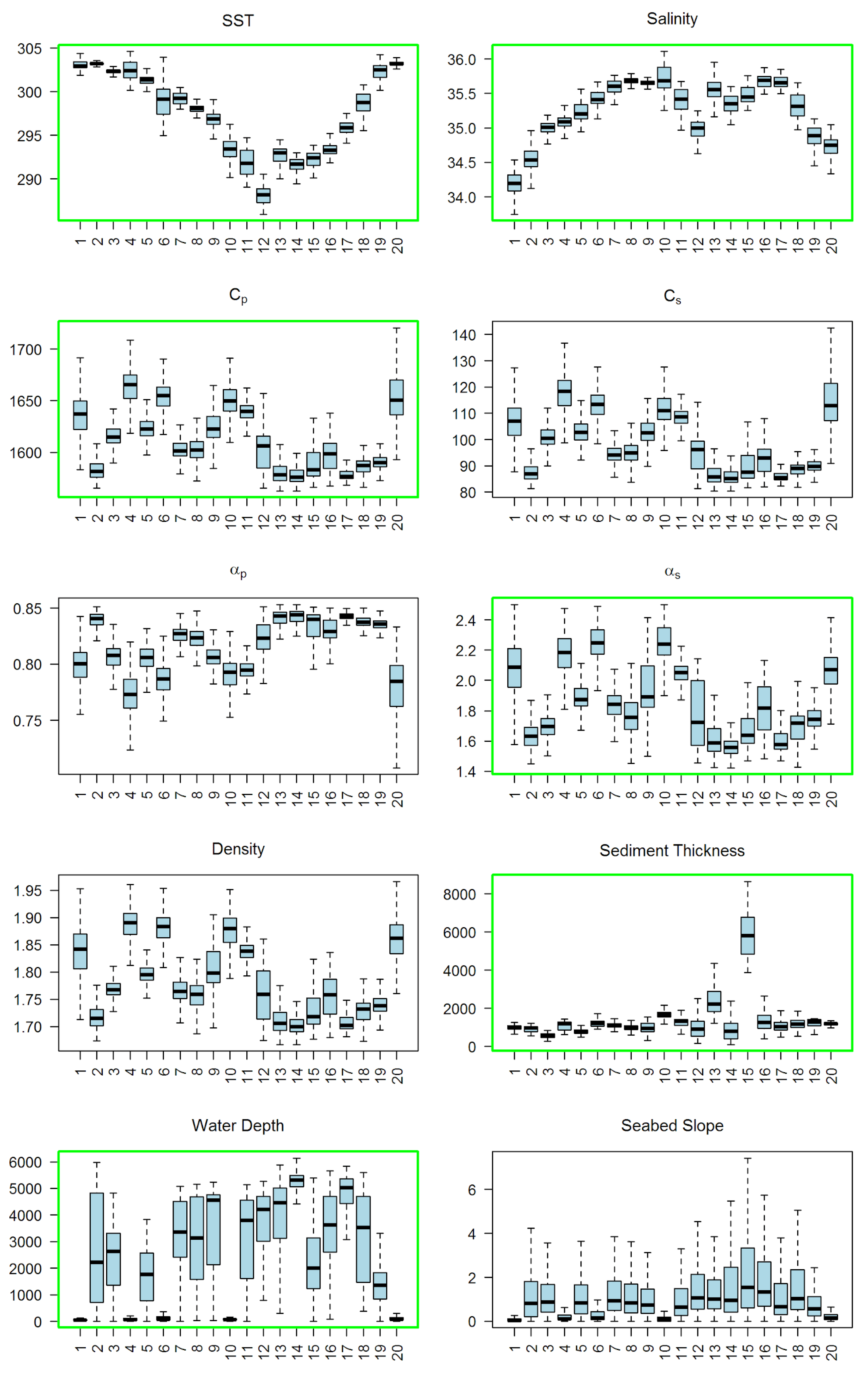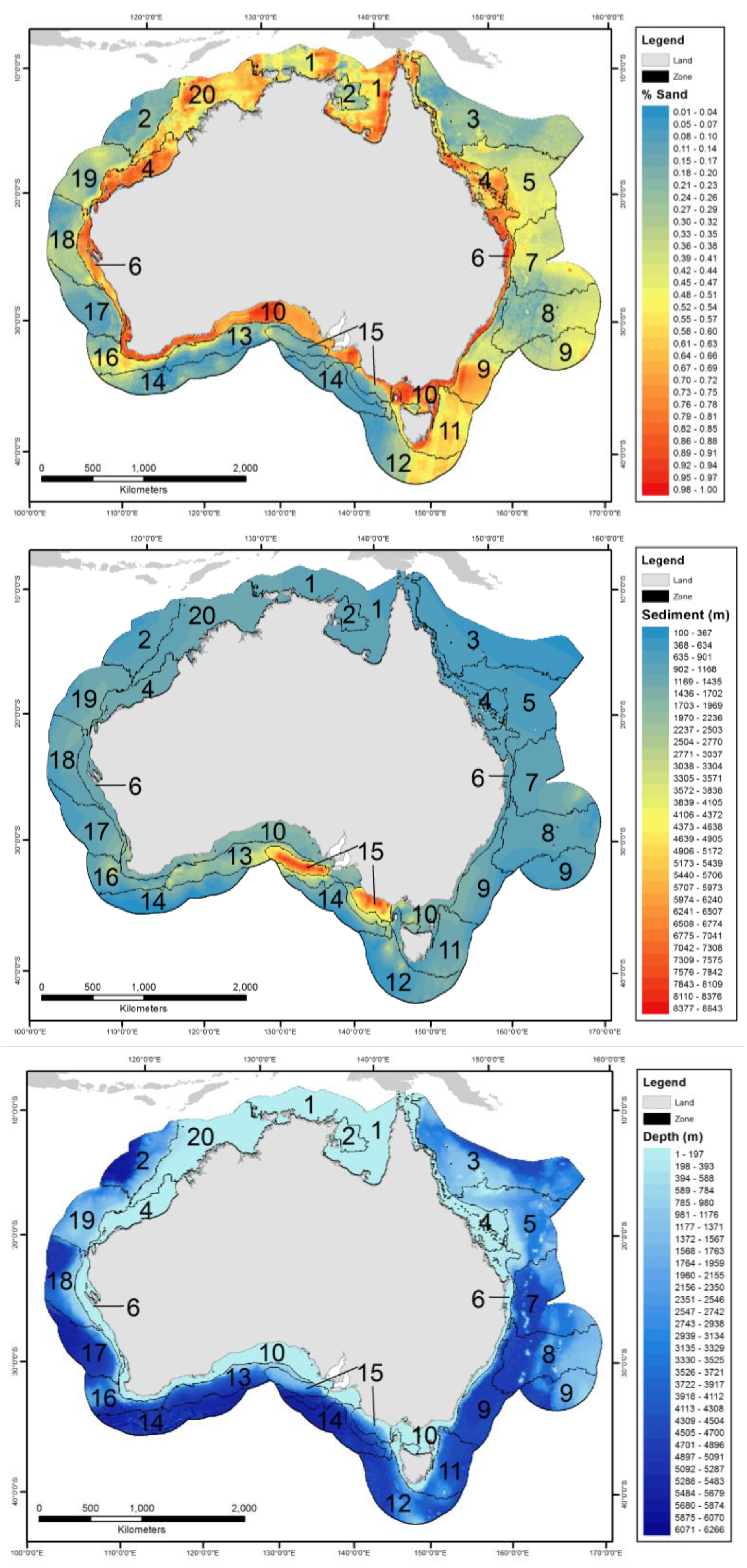Marine Acoustic Zones of Australia
Abstract
:1. Introduction
2. Materials and Methods
2.1. Data
2.2. Clustering Model
3. Results
4. Discussion
Author Contributions
Funding
Institutional Review Board Statement
Informed Consent Statement
Data Availability Statement
Conflicts of Interest
Appendix A

| Split Zone | Zone | Depth [m] | Slope [Degrees] | Sediment Thickness [m] | Cp [m/s] | Cs [m/s] | αp [dB/λ] | αs [dB/λ] | Density [kg/m3] |
|---|---|---|---|---|---|---|---|---|---|
| 1 | 1 | 51 ± 49 | 0.1 ± 0.5 | 990 ± 139 | 1635 ± 23 | 107 ± 9 | 0.8 ± 0.02 | 2.05 ± 0.18 | 1833 ± 45 |
| 2 | 2 | 54 ± 9 | 0 ± 0.1 | 1013 ± 26 | 1599 ± 12 | 93 ± 5 | 0.83 ± 0.01 | 1.76 ± 0.10 | 1752 ± 26 |
| 3 | 3 | 2460 ± 1230 | 1.4 ± 1.8 | 580 ± 132 | 1617 ± 13 | 101 ± 5 | 0.81 ± 0.01 | 1.70 ± 0.09 | 1770 ± 24 |
| 4 | 4 | 118 ± 166 | 0.5 ± 1.3 | 876 ± 53 | 1654 ± 23 | 114 ± 10 | 0.78 ± 0.02 | 2.12 ± 0.13 | 1866 ± 37 |
| 5 | 5 | 1773 ± 966 | 1.5 ± 2.2 | 764 ± 114 | 1624 ± 13 | 103 ± 5 | 0.8 ± 0.01 | 1.88 ± 0.09 | 1800 ± 23 |
| 6 | 6 | 136 ± 166 | 0.6 ± 1.5 | 1100 ± 131 | 1659 ± 13 | 115 ± 6 | 0.78 ± 0.02 | 2.27 ± 0.11 | 1888 ± 21 |
| 7 | 7 | 3354 ± 1085 | 1.8 ± 2.7 | 1163 ± 231 | 1603 ± 11 | 95 ± 4 | 0.83 ± 0.01 | 1.83 ± 0.10 | 1765 ± 24 |
| 8 | 8 | 3151 ± 1438 | 1.6 ± 2.5 | 976 ± 154 | 1603 ± 13 | 95 ± 5 | 0.82 ± 0.01 | 1.76 ± 0.11 | 1757 ± 26 |
| 9 | 9 | 2590 ± 1398 | 1.1 ± 1.2 | 808 ± 138 | 1619 ± 7 | 101 ± 2 | 0.81 ± 0.01 | 1.85 ± 0.08 | 1789 ± 17 |
| 10 | 9 | 4375 ± 909 | 1.9 ± 3.3 | 1165 ± 275 | 1626 ± 18 | 103 ± 6 | 0.81 ± 0.01 | 2.00 ± 0.19 | 1814 ± 43 |
| 11 | 10 | 106 ± 176 | 0.5 ± 1.7 | 1741 ± 509 | 1655 ± 16 | 114 ± 7 | 0.79 ± 0.02 | 2.28 ± 0.12 | 1884 ± 29 |
| 12 | 11 | 3032 ± 1758 | 1.4 ± 2.4 | 1278 ± 316 | 1638 ± 13 | 108 ± 5 | 0.8 ± 0.01 | 2.06 ± 0.11 | 1836 ± 26 |
| 13 | 12 | 3821 ± 1057 | 1.9 ± 2.6 | 988 ± 490 | 1603 ± 22 | 95 ± 8 | 0.82 ± 0.02 | 1.77 ± 0.21 | 1758 ± 51 |
| 14 | 13 | 4389 ± 1310 | 2.4 ± 3.5 | 2768 ± 768 | 1579 ± 8 | 86 ± 3 | 0.84 ± 0.01 | 1.59 ± 0.07 | 1706 ± 17 |
| 15 | 14 | 5258 ± 380 | 0.9 ± 1.6 | 1099 ± 471 | 1575 ± 5 | 85 ± 2 | 0.84 ± 0.00 | 1.54 ± 0.04 | 1696 ± 10 |
| 16 | 15 | 1867 ± 1527 | 2.4 ± 2.8 | 5704 ± 1083 | 1606 ± 34 | 96 ± 12 | 0.82 ± 0.03 | 1.83 ± 0.30 | 1768 ± 77 |
| 17 | 10 | 133 ± 289 | 0.6 ± 2.0 | 1723 ± 333 | 1649 ± 17 | 111 ± 7 | 0.79 ± 0.02 | 2.24 ± 0.12 | 1870 ± 32 |
| 18 | 15 | 2406 ± 1256 | 2.8 ± 3.6 | 5972 ± 1137 | 1588 ± 23 | 90 ± 9 | 0.83 ± 0.02 | 1.65 ± 0.13 | 1726 ± 45 |
| 19 | 13 | 3674 ± 1535 | 1.8 ± 2.8 | 2232 ± 645 | 1581 ± 12 | 87 ± 4 | 0.84 ± 0.01 | 1.63 ± 0.13 | 1714 ± 30 |
| 20 | 14 | 5229 ± 353 | 3.2 ± 4.1 | 672 ± 439 | 1580 ± 10 | 87 ± 4 | 0.84 ± 0.01 | 1.60 ± 0.09 | 1709 ± 23 |
| 21 | 16 | 3616 ± 1252 | 2.5 ± 3.5 | 1339 ± 553 | 1597 ± 14 | 92 ± 5 | 0.83 ± 0.01 | 1.81 ± 0.16 | 1755 ± 36 |
| 22 | 17 | 4478 ± 1388 | 1.8 ± 3.4 | 1094 ± 317 | 1579 ± 6 | 86 ± 2 | 0.84 ± 0.00 | 1.60 ± 0.08 | 1708 ± 16 |
| 23 | 6 | 156 ± 229 | 0.4 ± 0.8 | 1349 ± 164 | 1648 ± 17 | 111 ± 7 | 0.79 ± 0.02 | 2.21 ± 0.12 | 1867 ± 32 |
| 24 | 18 | 3180 ± 1587 | 1.9 ± 2.6 | 1163 ± 225 | 1586 ± 8 | 89 ± 3 | 0.84 ± 0.01 | 1.69 ± 0.10 | 1728 ± 22 |
| 25 | 19 | 1515 ± 692 | 1.0 ± 1.1 | 1269 ± 171 | 1591 ± 9 | 90 ± 3 | 0.84 ± 0.01 | 1.75 ± 0.10 | 1740 ± 22 |
| 26 | 4 | 65 ± 54 | 0.1 ± 0.2 | 1319 ± 81 | 1671 ± 20 | 121 ± 9 | 0.77 ± 0.02 | 2.24 ± 0.11 | 1901 ± 24 |
| 27 | 2 | 3244 ± 1782 | 1.9 ± 2.6 | 891 ± 170 | 1580 ± 8 | 87 ± 3 | 0.84 ± 0.01 | 1.62 ± 0.08 | 1712 ± 19 |
| 28 | 20 | 135 ± 134 | 0.3 ± 0.6 | 1200 ± 49 | 1655 ± 28 | 115 ± 12 | 0.78 ± 0.03 | 2.07 ± 0.13 | 1861 ± 40 |
References
- Juda, L. The exclusive economic zone and ocean management. Ocean Dev. Int. Law 1987, 18, 305–331. [Google Scholar] [CrossRef]
- Erbe, C. International regulation of underwater noise. Acoust. Aust. 2013, 41, 12–19. [Google Scholar]
- Erbe, C. Underwater noise from pile driving in Moreton Bay, Qld. Acoust. Aust. 2009, 37, 87–92. [Google Scholar]
- Erbe, C.; King, A.R. Modeling cumulative sound exposure around marine seismic surveys. J. Acoust. Soc. Am. 2009, 125, 2443–2451. [Google Scholar] [CrossRef] [PubMed]
- Jensen, F.B.; Kuperman, W.A.; Porter, M.B.; Schmidt, H. Computational Ocean Acoustics, 2nd ed.; Springer: New York, NY, USA, 2011. [Google Scholar]
- Integrated Marine Observing System (IMOS). IMOS—SRS—SST—L4—GAMSSA—Australia Database. Available online: https://portal.aodn.org.au (accessed on 9 October 2019).
- Boutin, J.; Vergely, J.-L.; Koehler, J.; Rouffi, F.; Reul, N. ESA Sea Surface Salinity Climate Change Initiative (Sea_Surface_Salinity_cci): Version 1.8 Data Collection. Centre Environ. Data Anal. 2019. [Google Scholar] [CrossRef]
- Barlow, J. Global Ocean Sound Speed Profile Library (GOSSPL), An RData Resource for Studies of Ocean Sound Propagation (NOAA Technical Memorandum No. NMFS-SWFSC-612); U.S. Department of Commerce: La Jolla, CA, USA, 2019. [CrossRef]
- MacKenzie, K.V. Nine-term equation for sound speed in the oceans. J. Acoust. Soc. Am. 1981, 70, 807–812. [Google Scholar] [CrossRef]
- Carnes, M.R. Description and Evaluation of GDEM-V 3.0 (Memorandum Report No. NRL/MR/7330--09-9165); Naval Research Laboratory, United States Navy: Stennis Space Center, MS, USA, 2009. [Google Scholar]
- Li, J.; Heap, A.D.; Potter, A.; Daniell, J.J. Predicting Seabed Mud Content Across the Australian Margin II: The Performance of Machine Learning Methods and Their Combinations with Ordinary Kriging and Inverse Distance Squared; Record 2011/07, GeoCat No. 71407; Geoscience Australia: Canberra, Australia, 2011.
- Geoscience Australia. Marine Sediments (MARS) Database. Available online: http://dbforms.ga.gov.au/pls/www/npm.mars.search (accessed on 21 December 2020).
- Straume, E.O.; Gaina, C.; Medvedev, S.; Hochmuth, K.; Gohl, K.; Whittaker, J.M.; Fattah, R.A.; Doornenbal, J.C.; Hopper, J.R. GlobSed: Updated Total Sediment Thickness in the World’s Oceans. Geochem. Geophys. Geosyst. 2019, 20, 1756–1772. [Google Scholar] [CrossRef]
- Duncan, A.J.; Gavrilov, A.; Fan, L. Acoustic propagation over limestone seabeds. In Proceedings of the Acoustics 2009, Adelaide, Australia, 23–25 November 2009. [Google Scholar]
- Santosh, M.; Maruyama, S.; Komiya, T.; Yamamoto, S. Orogens in the evolving Earth: From surface continents to ‘lost continents’ at the core–mantle boundary. Geol. Soc. Lond. Spéc. Publ. 2010, 338, 77–116. [Google Scholar] [CrossRef]
- Whiteway, T.G. Australian Bathymetry and Topography Grid, June 2009; Record 2009/21, GeoCat No. 67703; Geoscience Australia: Canberra, Australia, 2009.
- Wood, S.N. Generalized Additive Models: An Introduction with R, 2nd ed.; CRC Press: Boca Raton, FL, USA, 2017. [Google Scholar]
- McLachlan, G.J.; Peel, D. Finite Mixture Models; John Wiley & Sons: New York, NY, USA, 2000. [Google Scholar]
- Dempster, A.P.; Laird, N.M.; Rubin, D.B. Maximum likelihood from incomplete data via the EM algorithm. J. R. Stat. Soc. Ser. B 1977, 39, 1–22. [Google Scholar]
- Bradski, G. The OpenCV Library. Dr. Dobb’s J. Softw. Tools 2000, 25, 120–125. [Google Scholar]
- Erbe, C.; MacGillivray, A.; Williams, R. Mapping cumulative noise from shipping to inform marine spatial planning. J. Acoust. Soc. Am. 2012, 132, EL423–EL428. [Google Scholar] [CrossRef] [PubMed] [Green Version]
- Erbe, C.; Farmer, D.M. Zones of impact around icebreakers affecting beluga whales in the Beaufort Sea. J. Acoust. Soc. Am. 2000, 108, 1332–1340. [Google Scholar] [CrossRef] [PubMed] [Green Version]
- Erbe, C.; Williams, R.; Sandilands, D.; Ashe, E. Identifying Modeled Ship Noise Hotspots for Marine Mammals of Canada’s Pacific Region. PLoS ONE 2014, 9, e89820. [Google Scholar] [CrossRef]
- Williams, R.; Erbe, C.; Ashe, E.; Clark, C.W. Quiet(er) marine protected areas. Mar. Pollut. Bull. 2015, 100, 154–161. [Google Scholar] [CrossRef]







| Group Variable | Derived Variable | Input Variable | Source |
|---|---|---|---|
| Water Column | sea surface temperature | sea surface temperature | [6] |
| sea surface salinity | sea surface salinity | [7] | |
| sound speed gradient profile | sound speed profile | [8] | |
| Seafloor | compressional sound speed, shear sound speed, compressional absorption coefficient, shear absorption coefficient, density | % clay | |
| % silt | [11] | ||
| % sand | |||
| % gravel | |||
| sediment thickness | sediment thickness | [13] | |
| bedrock type | bedrock type | [14,15] | |
| Bathymetry | water depth | water depth | [16] |
| Zone | Name | Description |
|---|---|---|
| 1 | Northern Tropical Shelf | Hot northern zone, shallow water with low salinity. Borders appear to align with salinity change. |
| 2 | Muddy Tropical Shallow | Two areas of northern Australia, one offshore in the West and one in shallow water in the Gulf of Carpentaria. Their predominant features are a muddy seabed, hot temperature, and low salinity. |
| 3 | Eastern Tropical 1 | Excludes coastal waters but spans a range of depths. Separate from neighbouring Zone 5 to the South by water column sound speed profile. Zones 1–3 and 20 have the steepest downward refracting gradients. An abrupt change in salinity defines the border with Zone 1. |
| 4 | Tropical Shelf | Exists on both coasts. Mostly shallow, sandy, coastal water. Hot temperature, medium salinity. |
| 5 | Eastern Tropical 2 | Geoacoustic parameters drive the border with Zone 4, hydroacoustic parameters (i.e., sound speed profiles) drive the borders with Zones 3 and 7. |
| 6 | Sub-Tropical to Temperate Shelf | Exists on both coasts. Warm, shallow, sandy. |
| 7 | Eastern Sub-Tropical Deep | Inner bound at continental shelf. Hydroacoustic parameters drive the separation from Zone 8. |
| 8 | Eastern Temperate Deep 1 | Inner bound at continental shelf. High sea surface salinity. Less downward refracting than Zone 7. |
| 9 | Eastern Temperate Deep 2 | Inner bound at continental shelf. High salinity. Less downward refracting than Zone 8. |
| 10 | Southern Temperate Shelf | Shallow water bounded by the continental slope. High salinity. Sandy seafloor. |
| 11 | Southern Cold | Covers shallow coastal Tasmania but also extends to deep water South-East of Tasmania. Cold water with a strong surface duct in July. |
| 12 | Southern Cold Deep | Most southerly zone. Cold. Less saline surface water than Zone 11. The least sound-focussing sound speed profiles. |
| 13 | Great Australian Bight Temperate Deep 1 | Southern, cold, deep. Inner bound at continental shelf. Shallower yet thicker sediment than Zone 14. |
| 14 | Great Australian Bight Temperate Deep 2 | Southern, cold, deep. |
| 15 | Southern Thick Sediment | An area (2 locations) between Zones 10 and 13 with very high sediment thickness. |
| 16 | Western Temperate Deep 1 | Offshore with a sandy, shallower band resulting in different seabed acoustic properties from neighbouring Zones 14 and 17. Sound speed gradients at 40–1000 m different from neighbouring zones. Inner bound at continental shelf. |
| 17 | Western Temperate Deep 2 | Inner bound at continental shelf. Cooler and more saline than Zone 18 to the North. |
| 18 | Western Sub-Tropical Deep | Offshore, warm. Inner bound at continental shelf. |
| 19 | Western Tropical Offshore | Warm-hot. Downward refracting July profile. Inner bound at continental shelf. Shallower than Zone 2 to the North and Zone 18 to the South. |
| 20 | Western Tropical Shelf | Shallow water. Wide, sandy continental shelf. Hot sea surface; strongly downward refracting. |
| Zone | Depth [m] | Slope [Degrees] | Sediment Thickness [m] | Cp [m/s] | Cs [m/s] | αp [dB/λ] | αs [dB/λ] | Density [kg/m3] |
|---|---|---|---|---|---|---|---|---|
| 1 | 51 ± 49 | 0.1 ± 0.5 | 990 ± 139 | 1635 ± 23 | 107 ± 9 | 0.80 ± 0.02 | 2.05 ± 0.18 | 1833 ± 45 |
| 2 | 2583 ± 2047 | 1.5 ± 2.4 | 917 ± 160 | 1584 ± 12 | 88 ± 4 | 0.84 ± 0.01 | 1.65 ± 0.10 | 1720 ± 26 |
| 3 | 2460 ± 1230 | 1.4 ± 1.8 | 580 ± 132 | 1617 ± 13 | 101 ± 5 | 0.81 ± 0.01 | 1.70 ± 0.09 | 1770 ± 24 |
| 4 | 94 ± 131 | 0.4 ± 1.0 | 1076 ± 230 | 1662 ± 23 | 117 ± 10 | 0.78 ± 0.03 | 2.17 ± 0.13 | 1882 ± 37 |
| 5 | 1773 ± 966 | 1.6 ± 2.2 | 764 ± 114 | 1624 ± 13 | 103 ± 5 | 0.80 ± 0.01 | 1.89 ± 0.09 | 1800 ± 23 |
| 6 | 146 ± 200 | 0.5 ± 1.2 | 1225 ± 194 | 1654 ± 16 | 113 ± 7 | 0.79 ± 0.02 | 2.24 ± 0.12 | 1878 ± 29 |
| 7 | 3354 ± 1085 | 1.8 ± 2.7 | 1163 ± 231 | 1603 ± 11 | 95 ± 4 | 0.83 ± 0.01 | 1.83 ± 0.10 | 1765 ± 24 |
| 8 | 3151 ± 1438 | 1.6 ± 2.5 | 976 ± 154 | 1603 ± 13 | 95 ± 5 | 0.82 ± 0.01 | 1.76 ± 0.11 | 1757 ± 26 |
| 9 | 3588 ± 1452 | 1.6 ± 2.6 | 1008 ± 287 | 1623 ± 15 | 102 ± 5 | 0.81 ± 0.01 | 1.93 ± 0.17 | 1803 ± 37 |
| 10 | 126 ± 265 | 0.5 ± 1.9 | 1727 ± 386 | 1650 ± 17 | 112 ± 7 | 0.79 ± 0.02 | 2.25 ± 0.12 | 1874 ± 32 |
| 11 | 3032 ± 1758 | 1.4 ± 2.4 | 1278 ± 316 | 1638 ± 13 | 108 ± 5 | 0.80 ± 0.01 | 2.06 ± 0.11 | 1836 ± 26 |
| 12 | 3821 ± 1057 | 1.9 ± 2.6 | 988 ± 490 | 1603 ± 22 | 95 ± 8 | 0.82 ± 0.02 | 1.77 ± 0.21 | 1758 ± 51 |
| 13 | 3899 ± 1505 | 2.0 ± 3.1 | 2401 ± 730 | 1580 ± 11 | 87 ± 4 | 0.84 ± 0.01 | 1.62 ± 0.12 | 1711 ± 27 |
| 14 | 5240 ± 364 | 2.3 ± 3.5 | 840 ± 498 | 1578 ± 9 | 86 ± 3 | 0.84 ± 0.01 | 1.57 ± 0.08 | 1704 ± 20 |
| 15 | 2157 ± 1413 | 2.6 ± 3.2 | 5848 ± 1120 | 1596 ± 30 | 92 ± 11 | 0.83 ± 0.02 | 1.73 ± 0.24 | 1745 ± 65 |
| 16 | 3616 ± 1252 | 2.5 ± 3.5 | 1339 ± 553 | 1597 ± 14 | 92 ± 5 | 0.83 ± 0.01 | 1.81 ± 0.16 | 1755 ± 36 |
| 17 | 4478 ± 1388 | 1.8 ± 3.4 | 1094 ± 317 | 1579 ± 6 | 86 ± 2 | 0.84 ± 0.00 | 1.60 ± 0.08 | 1708 ± 16 |
| 18 | 3180 ± 1587 | 1.9 ± 2.6 | 1163 ± 225 | 1586 ± 8 | 89 ± 3 | 0.84 ± 0.01 | 1.70 ± 0.10 | 1728 ± 22 |
| 19 | 1515 ± 692 | 1.0 ± 1.1 | 1269 ± 171 | 1591 ± 9 | 90 ± 3 | 0.84 ± 0.01 | 1.75 ± 0.10 | 1740 ± 22 |
| 20 | 135 ± 0134 | 0.3 ± 0.7 | 1200 ± 49 | 1655 ± 28 | 115 ± 12 | 0.78 ± 0.03 | 2.07 ± 0.13 | 1861 ± 40 |
Publisher’s Note: MDPI stays neutral with regard to jurisdictional claims in published maps and institutional affiliations. |
© 2021 by the authors. Licensee MDPI, Basel, Switzerland. This article is an open access article distributed under the terms and conditions of the Creative Commons Attribution (CC BY) license (http://creativecommons.org/licenses/by/4.0/).
Share and Cite
Erbe, C.; Peel, D.; Smith, J.N.; Schoeman, R.P. Marine Acoustic Zones of Australia. J. Mar. Sci. Eng. 2021, 9, 340. https://doi.org/10.3390/jmse9030340
Erbe C, Peel D, Smith JN, Schoeman RP. Marine Acoustic Zones of Australia. Journal of Marine Science and Engineering. 2021; 9(3):340. https://doi.org/10.3390/jmse9030340
Chicago/Turabian StyleErbe, Christine, David Peel, Joshua N. Smith, and Renee P. Schoeman. 2021. "Marine Acoustic Zones of Australia" Journal of Marine Science and Engineering 9, no. 3: 340. https://doi.org/10.3390/jmse9030340







